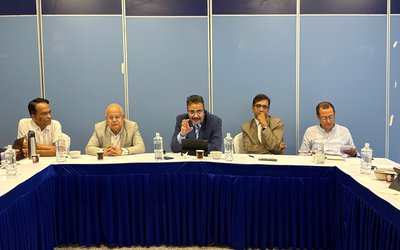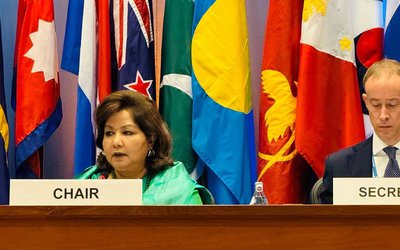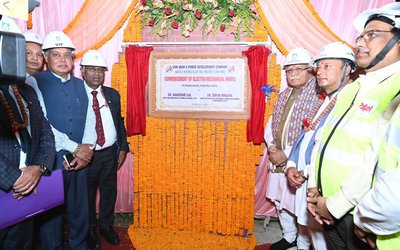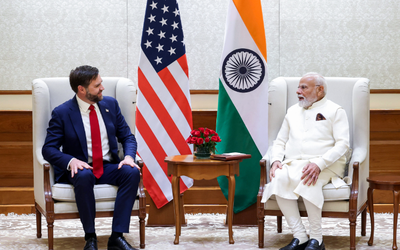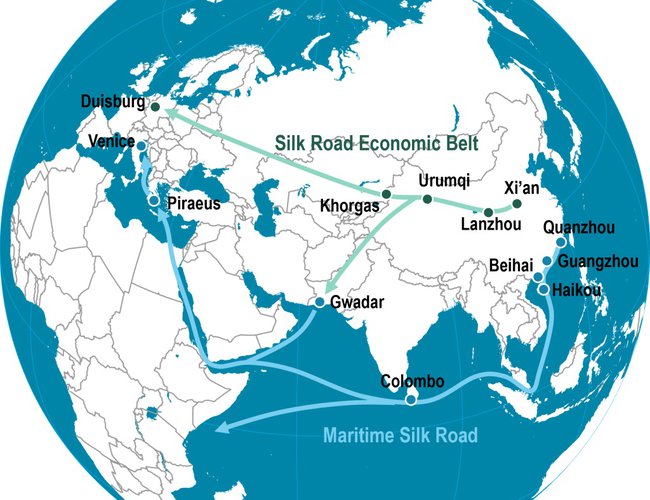
In a recent development, the "Belt and Road Cooperation and Partnership Agreement," commonly referred to as the "Model Agreement," was officially unveiled in Hong Kong on October 13, 2023, during the 6th 'Belt and Road' Initiative International Forum. This significant event was a collaborative effort organized by the International Academy of "Belt and Road," the Hong Kong WTO Research Institute, and the Academy of International Strategy and Law at Zhejiang University.
The Model Agreement, a non-governmental initiative, aims to address numerous critical issues associated with China's Belt and Road Initiative (BRI), often recognized as the New Silk Road. However, the BRI in its current form is widely regarded as one of the most extensive and ambitious infrastructure projects ever conceived, and involves numerous countries and regions, aiming to improve connectivity, trade, and economic development on a massive scale. Whether it is the "biggest" modern project can be a matter of perspective and criteria. It certainly ranks among the largest and most far-reaching initiatives of its kind in recent history. The Model Agreement is anticipated to offer soft norms for the consideration of the contracting parties to facilitate the creation of a mutually beneficial arrangement for BRI projects.
A Comprehensive Expert Document
The Model Agreement, a comprehensive expert document, comprises 15 key chapters addressing all legitimate criticisms directed at the BRI as a global project. These chapters cover a wide range of critical areas, including General Principles and Definitions, Right to Development, Sustainable Development, Transparency and Anti-Corruption, Facilitation of Trade in Goods, Services, and Service Providers, Digital Economy and Cybersecurity, Investment, Intellectual Property, Public Health, Finance, Infrastructure, Competition, Environment, Labor Standards, and Dispute Resolution.
The provisions within these chapters within the Model Agreement are primarily tailored to deal with the legitimate criticisms and meet the requirements of both current and potential participant nations in the Belt and Road Initiative (BRI). It strives to strike a delicate balance between the needs of developing and least developed countries and the overall development of the region and the world as a whole.
While adhering to the fundamental principles and regulations of the existing international order, the "Model Agreement" has attempted to carefully address the specific goals and requirements of the BRI. This adaptation ensures that the Agreement aligns with the BRI's distinct purpose while upholding and promoting the established principles of the international community.
In Article 8 of the Model Agreement, which pertains to transparency and anti-corruption, the general principle, for example, is established that the contracting parties commit to upholding transparency as a fundamental principle. This commitment entails making all information concerning BRI projects accessible to all interested parties. This information includes details about policies, laws, regulations, administrative rulings, licensing, certification, qualification and registration requirements, technical regulations, standards, guidelines, procedures, and practices, among other relevant matters. Importantly, this information should be consistently and promptly provided by the contracting parties, either free of charge or at a reasonable cost.
Additionally, the contracting parties express their collective dedication to eradicating bribery and corruption within BRI projects. Recognizing the necessity of fostering integrity in both the public and private sectors, they emphasize that each sector bears complementary responsibilities in this regard. In essence, this Article underscores the commitment to transparency and the joint effort to combat corruption, thereby promoting ethical and accountable practices within the Belt and Road Initiative.
The Model Agreement includes a broad commitment to principles such as sovereignty, good faith, the ‘pactasuntservanda’ principle (agreements must be kept), the rule of law, non-discrimination, due process, and cooperation between governments and stakeholders. It also emphasizes the standardization of business practices and ethical conduct.Article 20 of the Model Agreement specifically addresses dispute resolution. It stipulates that the contracting parties are obligated to resolve any disputes related to BRI projects through amicable and peaceful means. This approach is taken to ensure that the peace, security, and justice within the Belt and Road countries and regions are not put in jeopardy.
In sum, the Model Agreement serves as a comprehensive framework that effectively addresses many of the general concerns raised by various countries and experts regarding the Belt and Road Initiative. It promotes a commitment to ethical conduct, the rule of law, and peaceful dispute resolution, with the overarching goal of enhancing peace, security, and justice in the Belt and Road region.
Current Issues
Introduced in 2013 under the leadership of Chinese President Xi Jinping, this extensive array of development and investment initiatives initially aimed to connect East Asia and Europe through the establishment of physical infrastructure. Over the past decade, the initiative has significantly expanded its scope, reaching into Africa, Oceania, and Latin America, thereby substantially amplifying China's economic and political influence.
Some analysts view this expansion as a potentially disconcerting manifestation of China's increasing global influence. Furthermore, concerns have risen as the costs associated with many of these projects have soared, leading to opposition in certain host countries.
Simultaneously, according to James McBride, Noah Berman, and Andrew Chatzky,who contributed an article to the Council on Foreign Relations in New York recently, the United States shares the apprehensions of some Asian nations regarding the Belt and Road Initiative's potential as a Trojan horse for China-led regional development and military expansion. President Joe Biden has continued the skeptical stance toward Beijing's actions, following in the footsteps of his predecessors. However, Washington has encountered challenges in presenting a more attractive economic vision to the governments participating in the initiative.
According to these critics, the Belt and Road Initiative has not been without its share of detractors. In the eyes of certain nations that incur substantial debt to finance their infrastructure improvements, BRI funding is perceived as a possible double-edged sword. China regards BRI projects as commercial ventures, offering loans at rates approximating market interest rates, with the expectation of full repayment. However, some BRI investments have entailed less than transparent bidding procedures and mandated the involvement of Chinese firms. Consequently, the involvement of these contractors has led to cost inflation, causing the cancellation of projects and generating political pushback.
One of the most prominent criticisms revolves around the possibility of debt dependency induced by BRI projects in participating countries. Detractors assert that the substantial loans and financial assistance offered by China can lead to unsustainable debt burdens for these nations. Consequently, this could pave the way for economic and political reliance on China, potentially allowing Beijing to wield undue influence.
Furthermore, critics argue that BRI initiatives often lack transparency in their financial arrangements, concealing or failing to disclose crucial terms and conditions. This opacity can give rise to concerns about the actual costs and implications of involvement in BRI projects.
Large-scale BRI infrastructure projects, in particular, have raised concerns about their significant environmental and social impacts. Critics express apprehension regarding issues such as deforestation, habitat destruction, pollution, and the displacement of local communities. They contend that these concerns underscore an insufficient emphasis on environmental and social safeguards within the BRI framework.
Reports have emerged highlighting substandard construction quality and safety standards in certain BRI projects, prompting concerns about the long-term durability and safety of the infrastructure developed within the initiative. Critics have voiced these apprehensions, emphasizing the need for rigorous quality and safety controls.
Accusations of corruption have also marred some BRI projects, both within the host countries and among the Chinese companies involved. Critics argue that corruption and a lack of accountability can lead to mismanagement and inefficiencies within the initiative, undermining its overall goals.
Furthermore, a subset of critics perceives the BRI as a vehicle for China to extend its global influence and secure strategic advantages in various regions. They express reservations about Beijing's potential use of BRI projects for geopolitical and strategic objectives, underlining the need for vigilant assessment of the initiative's broader implications.
A term often associated with BRI criticism, "debt trap diplomacy" suggests that China intentionally extends loans to countries that it knows cannot repay, allowing China to seize assets or exert political influence when countries default on their BRI-related debts. Critics argue that BRI projects primarily benefit Chinese companies, promoting their economic interests and boosting infrastructure development in China itself. They contend that host countries may not receive equitable economic benefits. Critics express concerns about potential threats to the sovereignty and security of participating countries, particularly in regions with geopolitical tensions. They worry that BRI projects may compromise national security or strategic interests.
Against these odds, the success of the Belt and Road Initiative (BRI) hinges on several key elements: transparency and accountability in project selection and funding, a commitment to high-quality and sustainable infrastructure, addressing concerns regarding debt sustainability through responsible lending practices, fostering international collaboration and partnerships, engaging local communities, ensuring political stability in host countries, flexibility in adapting to changing circumstances, robust risk management strategies, a focus on economic viability and benefit sharing, and effective dispute resolution mechanisms. A long-term perspective and ongoing adaptation to evolving challenges are also critical for the BRI to achieve its goal of promoting regional and global development, trade, and cooperation while mitigating potential pitfalls and concerns. These are precisely the issues on which the Model Agreement helps contracting parties to mitigate.
The United States Transition
While these criticisms do exist, sometimes in an exaggerated form, the United States has transitioned from its initial ambivalence to near-complete skepticism regarding China's intentions and a clear desire to compete with the Belt and Road Initiative. During the Trump administration, the prevailing view was that the BRI was essentially an influence campaign that entrapped developing countries through "debt-trap diplomacy."
In response, the U.S. initiated a project in January 2022 to invest in 5 to 10 major infrastructure projects globally as part of a broader G-7 effort aimed at countering China's Belt and Road Initiative. The United States is prepared to provide developing nations with a comprehensive set of U.S. financial tools, encompassing equity stakes, loan guarantees, political insurance, grants, and technical expertise. These resources will be channeled towards areas such as climate, health, digital technology, and gender equality.
It's important to note that the U.S. International Development Finance Corporation, which plays a key role in these efforts, is a relatively recent establishment and is still in the process of identifying flagship projects. The aim is to have these projects up and running by the beginning of the next year. The Model Agreement can help them too.
Conclusion
It is essential to acknowledge that while these criticisms are articulated by some, it is also true that opinions on the Belt and Road Initiative (BRI) span a wide spectrum. There are nations and leaders who perceive significant value in participating in these projects, viewing them as opportunities for economic growth and development.
The impact and implications of the BRI are not monolithic; they are influenced by diverse perspectives and contextual factors. As China is marking the 10th anniversary of the BRI, an initiative that has garnered substantial support from the global community, there exists a shared aspiration for it to align with the trajectory of human development and peace. There is a mutual hope that the BRI can serve as a platform for realizing the fundamental goals of human dignity and world peace, as articulated in the UN Charter.
The recently introduced Model Agreement, collaboratively developed by an assembly of international scholars and experts, represents a compendium of recommendations in this direction. While these may appear as modest contributions, they have the potential to facilitate and enhance the engagement of countries in the Belt and Road Initiative. Ultimately, the path forward for the BRI involves a complex interplay of perspectives, negotiations, and ongoing efforts towards achieving the common objectives of global welfare, peace, and prosperity.

Dr. Bipin Adhikari
Dr Adhikari is a senior constitutional expert and the founding dean of the Kathmandu University School of Law). He can be reached at [lawyers_inc_nepal@yahoo.com]
- Belt And Road: No Belt, No Road – The Stalled Journey In Nepal
- Oct 26, 2023
- Mobilizing Resources For The University Of Nepal
- Jul 06, 2021
- Insight Into The Political Economy Of Nepal’s Development
- May 27, 2021
- Preliminary Part Of Padma Shamsher's Government Of Nepal Act, 1948
- May 04, 2020
- State Of Nepal’s Economy And Development Prior To The Introduction Of Padma Shamsher's Constitution
- Apr 20, 2020



